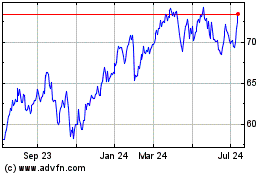MetLife Study Uncovers the Worries Caregivers in the Sandwich Generation Face
October 19 2010 - 8:45AM
Business Wire
Being a member of the working sandwich generation — those who
are holding down a full-time job while raising children and
simultaneously serving as a caregiver for older relatives — comes
with a steep price tag. New findings released today from MetLife’s
8th Annual Employee Benefits Trends Study help quantify some of the
pressures and costs and increasingly point to the workplace as a
potential source for assistance. About one in five full-time
employees is a caregiver of an older relative and nearly
three-quarters of these employees also have children under the age
of 18.
The MetLife study found significant differences with regard
to:
- Savings.
42% of employees with minor children, but without elder caregiving
responsibilities say they live paycheck to paycheck, compared to
64% of members of the working sandwich generation.
- Home
Ownership. 37% of working men and women with minor children
are very concerned about being able to afford to buy a home, but
that percentage doubles to 74% for those who are also
caregivers.
- College
Costs. 55% of workers with minor children are very concerned
about affording college, but that percentage climbs to 72% for
those who are also caregivers.
- Family
Time. While 45% of working parents are very concerned about
having more time to spend with their families, that percentage
jumps to 72% for those who are simultaneously balancing parental
and caregiving responsibilities.
“As the U.S. population ages, the percentage of employees who
are caregivers will continue to grow, and they will be looking to
employers for help and support. The MetLife study found that 64% of
caregivers with children worry less about unexpected health and
financial issues because of their workplace benefits, demonstrating
that employers can provide a real life line,” says Sandra
Timmermann, Ed.D., director of the MetLife Mature Market
Institute.
The study also indicated that members of the sandwich generation
are more likely to actively seek financial advice. Only 5% of this
demographic group say they don’t consult with anyone about their
personal finances, compared to 30% of non-caregiving employees with
children. These workers with book-end family responsibilities are
turning to multiple resources including:
Sandwich Non-Caregiving
Employees
Employees
w/Children
Financial Advisers 45% 24% Friends and Relatives 39% 17%
Insurance Agents 39% 7% Accountant 32% 9% Human Resources Dept. 26%
10% Financial Pubs/Web Sites 23% 13%
“There is a great appetite for information and financial advice
among members of the sandwich generation. Caregiving not only
impacts one’s current lifestyle, but also one’s view of the future.
For example, members of the sandwich generation have elevated
concerns about their own long-term care needs,” adds
Timmermann.
Seven out of ten working caregivers with minor children reported
that they are very concerned about their own long-term care needs
in retirement, contrasted to four out of ten non-caregiving
employees with children.
Study Methodology
The 8th Annual MetLife Study of Employee Benefits Trends was
conducted during the fourth quarter of 2009 and fielded by GfK
Custom Research North America. The employee sample comprised 1,305
interviews with full-time employees age 21 and over, at companies
with a minimum of two employees. The 8th Annual MetLife Study of
Employee Benefits Trends is available at
www.metlife.com/trends2010.
The MetLife Mature Market Institute®
Established in 1997, the Mature Market Institute (MMI) is
MetLife’s research organization and a recognized thought leader on
the multi-dimensional and multi-generational issues of aging and
longevity. MMI’s groundbreaking research, gerontology expertise,
national partnerships, and educational materials work to expand the
knowledge and choices for those in, approaching, or caring for
those in the mature market.
MMI supports MetLife’s long-standing commitment to identifying
emerging issues and innovative solutions for the challenges of
life. MetLife, Inc. (NYSE: MET), through its subsidiaries and
affiliates, is a leading provider of insurance, employee benefits
and financial services with operations throughout the United States
and the Latin American, Europe and Asia Pacific regions. For more
information about the MMI, please visit:
www.MatureMarketInstitute.com.
About MetLife
MetLife is a subsidiary of MetLife, Inc. (NYSE: MET), a leading
provider of insurance, employee benefits and financial services
with operations throughout the United States and the Latin America,
Europe and Asia Pacific regions. Through its subsidiaries and
affiliates, MetLife, Inc. reaches more than 70 million customers
around the world and MetLife is the largest life insurer in the
United States (based on life insurance in-force). The MetLife
companies offer life insurance, annuities, auto and home insurance,
retail banking and other financial services to individuals, as well
as group insurance and retirement & savings products and
services to corporations and other institutions. For more
information, visit www.metlife.com.
MetLife (NYSE:MET)
Historical Stock Chart
From Oct 2024 to Nov 2024

MetLife (NYSE:MET)
Historical Stock Chart
From Nov 2023 to Nov 2024
